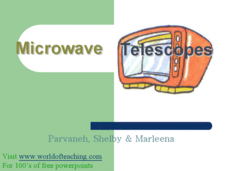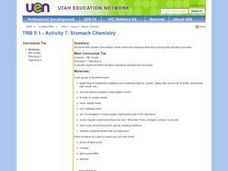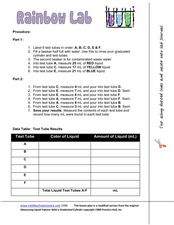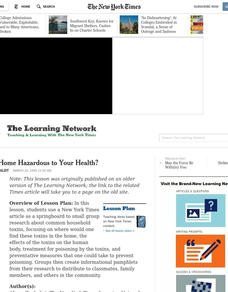Curated OER
What's "Out" There?
First graders investigate the five outer planets. In this space science lesson, 1st graders read the book Our Solar System and identify the five outer planets. Students create a booklet and write about outer planets.
Curated OER
How Much Carbon is Held by the World's Forests?
Seventh graders identify how much carbon is held by the world's forests. For this forestry activity, 7th graders study the carbon cycle and discuss what role humans have had on climate change. Students write a one page paper on how...
Mr. E. Science
Stars, Galaxies and the Universe
It takes 225 million years for our sun to travel around the galaxy. The presentation covers astronomical units, light years, telescopes, types of stars, the life cycle of a star, and types of galaxies. This is the last lesson in a...
Curated OER
Activity Three -- Rutherford's Discovery (Student Page ) A Lab Experiment in Physics
This discovery student page offers students an opportunity to work as a team to discover the shape of an object they cannot see. It is an experiment which parallels particle physicists dilemma in not being able to see very small...
Curated OER
Microwave Telescopes
Discovery of microwaves and other trivia starting this PowerPoint will help interest your class in the application and behavior of these radio waves. Great images to show real-life experiments and equipment help understanding of how the...
Curated OER
You Light Up My Life: Developing a Scientific Theory for What Fuels a Candle's Flame!
Students examine how candles work and how scientific theories are developed and tested. Students propose hypotheses about what is burning in a candle then perform tests in order to develop their scientific theory. After a teacher...
Curated OER
Stomach Chemistry
Fifth graders compare physical and chemical changes. They perform a simulation experiment/activity that replicates what happens in the stomach as food is digested by stomach acids.
Curated OER
The Scientific Method Using Mystery Powders
Learners use the scientific method to determine physical and chemical properties of unknown substances. In this scientific method lesson plan, students discuss chemical and physical properties of substances as a class after a...
Curated OER
Applied Science -Physics (2B) Pre Lab
Second graders look at different types of energy. In this energy lesson, 2nd graders define energy and the difference between kinetic and potential energy. They see examples with falling books and a slinky.
Curated OER
Food Chain: what's for dinner?
Fourth graders identify where foods came from and sequence a food chain. In this food chain lesson, 4th graders define vocabulary related to food chains and order a food chain. Students follow the energy of a food chain. Students...
Curated OER
Physical and Chemical Properties
In this properties learning exercise, students write the correct term in the spaces beside each definition. Then, students unscramble the letters in the boxes to answer a riddle.
Curated OER
Rainbow Lab
In this mixtures instructional activity, students experiment with different amounts of solutes and solvents to make solutions. They observe color changes and look for chemical and physical changes in the test tubes. Students answer 5...
Curated OER
Applied Science - Physics (K) Post Lab
Students are introduced to electricity. In this electricity lesson, students listen to the book Switch on, Switch off by Melvin Berger and discuss the use of electricity in light switches. They create a picture of an atom using pom...
Curated OER
Is Your Home Hazardous to Your Health?
Students use a newspaper article as a springboard to small group research about common household toxins, focusing on where would one find these toxins in the home, the effects of the toxins on the human body and treatment for poisoning...
Curated OER
A Little Horse Sense
How have horses evolved over time? How do horse skulls reveal this evolution? How have the roles horses play changed over time? What kind of social structure do horse herds have? How should wild horse populations be managed? To find the...
Curated OER
Is Shep Sherman Innocent or Guilty?
Learners engage in this activity to use knowledge acquired in this unit to predict the outcome of the trial in Science Court. The students will then publish their predictions on Microsoft Word.
Curated OER
Light My Fire!
Students draw a diagram that shows the law of reflection. In this physics lesson plan, students investigate the relationship between the angle of incidence and angle of reflection. They explain how light travels as it reflects on a surface.
Curated OER
Magnetism
Students explore physical science by participating in a class science activity. In this magnet attribute lesson plan, students define a list of scientific vocabulary terms associated with magnets and participate in hands on magnet...
Curated OER
Circuits and Conductors
Students explore electricity by completing Internet activities. In this physical science lesson plan, students identify an electric circuit and describe the characteristics of conductors, giving examples as well. Students...
Curated OER
It is a Crash Test, Dummy
Young scholars research air bags on the Internet and use the information to design their own version of an air bag. After exploring the benefits and dangers of air bags students perform a chemistry lab in which they mix baking soda and...
California Polytechnic State University
Australian Geography Unit
At the heart of this resource is a beautifully detailed PowerPoint presentation (provided in PDF form) on the overall physical geography of Australia, basic facts about the country, Aboriginal history, and Australia culture and lifestyle.
Curated OER
Observations of Properties of Matter
To guide learners through observations of chemical samples in the lab, this resource asks them to give all formulas and complete the attached data sheet. There are multiple questions about categories of elements and general...
Teach Engineering
Package Those Foods!
Designing the right package — it's more than a pretty picture. Challenge small groups to design a food package. They must consider the type of food they are packaging and the package's ability to control the physical and...
InqueryPhysics
Interpreting Motion Graphs
Every movement in the world can be measured and even motionless objects can be significant indicators of movement. Focus on motion graphs that feature distance vs. time, speed vs. time, and positive and negative acceleration.























